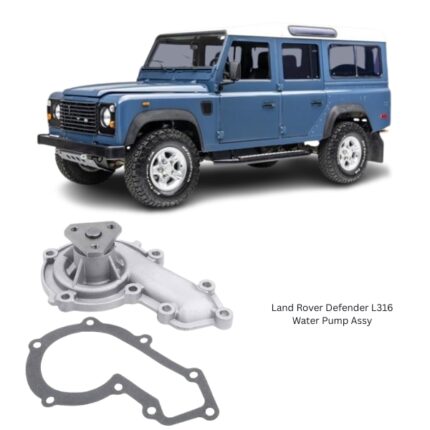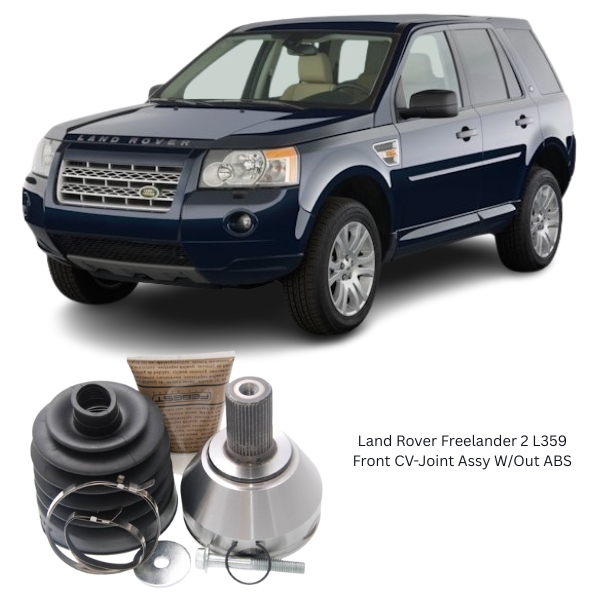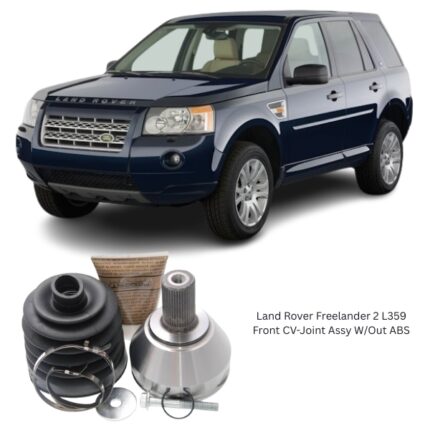Get Land Rover Freelander 2 L359 Front CV-Joint Assy W/Out ABS 2910-FLIIF in Kenya
The Front CV-Joint Assembly Without ABS (W/Out ABS) is a vital component in the drivetrain system of a front-wheel-drive or all-wheel-drive vehicle. Responsible for transmitting power from the vehicle’s transmission to the front wheels while allowing for smooth steering and suspension movement, the Constant Velocity (CV) joint is crucial to maintaining both vehicle performance and driving comfort.
This particular CV joint assembly is designed without ABS (Anti-lock Braking System) sensor integration, making it suitable for vehicles that either do not come equipped with ABS or use a separate ABS configuration. Manufactured to meet or exceed OEM specifications, this front CV-joint assembly ensures optimal fitment, reliability, and long-term performance.
1. What is a CV-Joint and Why It Matters
The term CV joint refers to a Constant Velocity joint, which is a mechanical coupling that allows a drive shaft to transmit power through a variable angle at a constant rotational speed, without an appreciable increase in friction or play. In front-wheel-drive vehicles and many modern all-wheel-drive systems, the CV joint is essential for enabling the wheels to turn left or right while also moving up and down with the suspension.
A front CV-joint must:
-
Deliver torque smoothly to the wheels during turns
-
Compensate for suspension movement
-
Handle both lateral and vertical forces
-
Provide long-lasting operation under various road conditions
A properly functioning CV joint directly impacts ride quality, steering control, and the overall safety of the vehicle.
2. Design and Structure
This Front CV-Joint Assembly Without ABS consists of the following core components:
-
Outer CV Joint (also known as the fixed joint): Connects directly to the front wheel hub and allows for wheel rotation at different angles.
-
Inner CV Joint (also known as the plunge joint): Connects to the transmission and compensates for the up-and-down motion of the suspension.
-
Drive shaft (axle shaft): Connects the inner and outer joints, transmitting power between them.
-
Boots and clamps: High-strength rubber boots filled with grease protect the joints from contamination and ensure lubrication.
-
Grease pack: Special CV-joint grease is included to minimize internal friction and wear.
This assembly is pre-lubricated and sealed, making it a ready-to-install, plug-and-play replacement solution.
3. ABS Sensor Exclusion
Unlike some CV-joint assemblies that come with a built-in ABS tone ring or magnetic encoder, this unit is built without an ABS provision. That means:
-
It’s meant for vehicles that do not utilize wheel-speed sensors on the CV-joint.
-
It eliminates potential sensor compatibility issues.
-
Installation is simpler, as there are no sensor connections to align or recalibrate.
This makes it ideal for older model vehicles or vehicles where ABS is either not installed or is handled separately via hub-mounted sensors.
4. Materials and Manufacturing
The Front CV-Joint Assembly is precision-engineered using high-strength alloys, typically including:
-
High-carbon steel or chromium-molybdenum (chromoly) for joint housings and internal components
-
Forged or machined steel for the shaft and bearing surfaces
-
Heat-treated surfaces to resist fatigue and wear under stress
-
Durable rubber compound boots designed to withstand heat, grease, salt, and debris
Each joint undergoes rigorous quality assurance testing, including:
-
Fatigue testing
-
Vibration analysis
-
Corrosion resistance checks
-
Torque load endurance tests
These strict standards ensure the CV-joint assembly meets or exceeds OEM durability expectations, even under aggressive driving conditions or rough terrain.
5. Fitment and Compatibility
This CV-joint assembly is designed to match OEM dimensions and splines, ensuring exact fitment and compatibility. It typically includes:
-
Correct spline count and diameter
-
Proper length and shaft size
-
OE-style boot design and clamp placement
-
Flange or threaded end (depending on vehicle model)
Since it is built without an ABS ring, it must be used on vehicles with non-ABS front wheel setups or where ABS sensors are located elsewhere (e.g., hub-based or separate wheel sensors).
To ensure proper fitment, it is essential to:
-
Cross-reference the part number with OEM or vehicle service data
-
Verify the spline count on both inner and outer ends
-
Match the overall length to the factory original
6. Performance and Benefits
A newly installed Front CV-Joint Assembly without ABS offers several critical advantages:
-
Smooth, quiet power delivery with no vibration or clicking noises
-
Improved cornering and acceleration performance
-
Reduced drivetrain slack, which enhances throttle response
-
Enhanced durability compared to worn or rebuilt units
-
Sealed-for-life design, requiring no further maintenance
Replacing a worn or damaged CV joint ensures that the vehicle retains its original ride quality and handling characteristics, restoring confidence and performance.
7. Common Signs of a Worn CV Joint
It is important to recognize symptoms that may indicate a need for CV-joint replacement:
-
Clicking, popping, or clunking noises during turns
-
Vibration or shaking during acceleration
-
Grease splatter inside the wheel or along the suspension
-
Torn or leaking rubber boots
-
Excessive play in the drive shaft
-
Knocking sounds under braking or gear changes
If any of these signs are present, timely replacement of the CV joint is critical to prevent complete joint failure, which could lead to loss of power to the wheels or a compromised steering response.
8. Installation Tips
Installing a front CV-joint assembly should be done by a qualified technician or experienced DIY enthusiast. Key considerations during installation include:
-
Ensuring the splines and threads are clean and properly lubricated
-
Using new axle nuts and cotter pins where applicable
-
Torqueing all fasteners to factory specifications
-
Ensuring the boot is not pinched or twisted
-
Verifying that the joint rotates and plunges smoothly after installation
A test drive after installation is recommended to ensure the absence of vibration, noise, or driveline backlash.
9. Maintenance and Longevity
While CV joints are designed to be maintenance-free, their lifespan can be maximized through:
-
Regular inspection of the boots for cracks or tears
-
Prompt cleaning and re-lubrication in case of minor boot damage
-
Avoiding aggressive off-roading or overloading the vehicle
-
Ensuring wheel alignment and suspension components are in good condition
With proper care, a quality CV-joint assembly can last 100,000 km or more, depending on road conditions and driving habits.
Follow us on Facebook for more parts.





Reviews
Clear filtersThere are no reviews yet.